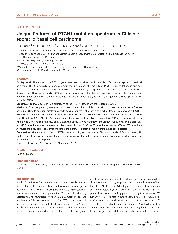摘要
Background Alterations of the PTCH1 gene have been found to contribute to both familial and sporadic basal cell carcinoma (BCC), especially in Caucasian patients. Furthermore, the majority of PTCH1 gene mutations in sporadic BCCs in Caucasian patients carry ultraviolet (UV) signatures, suggesting the key role of UV light in BCC development. However, sporadic BCC in non-Caucasian population has a lower incidence, and the pathogenesis remains largely unknown. To date, there has been no mutation analysis on PTCH1 gene in Chinese patients with sporadic BCCs.
Objective To investigate genetic alterations of the PTCH1 gene in Chinese sporadic BCCs.
Methods Direct sequencing was used to screen for mutations in PTCH1 in 31 microdissected samples in Chinese sporadic BCCs. In addition, single nucleotide polymorphisms (SNPs) were studied for loss of heterozygosity (LOH).
Results Nineteen PTCH1 mutations in 17 of the 31 BCCs (54.8%) were identified. SNP analysis revealed LOH of PTCH1 in 10 of 23 BCCs (43.5%). Interestingly, the majority of mutations identified (63.2%) were insertion/deletion, which was different from the results in Caucasian cases whose mutations are predominantly point mutations. Only two (10.5%) of the remaining seven mutations were UV-specific C --> T transition or tandem CC --> TT transitions. All mutations occurred evenly throughout the entire PTCH1 protein domain without a hot-spot detected.
Conclusion Mutations and LOH in PTCH1 were also highly prevalent in Chinese sporadic BCCs. However, UV light plays a less role in causing these mutations, suggesting other potential mechanisms in the development of sporadic BCC in Chinese patients.
- 出版日期2013-2
- 单位北京大学
